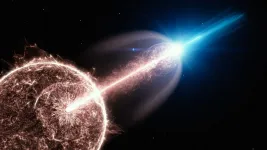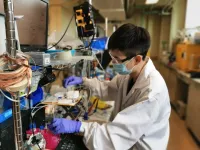(Press-News.org) Scientists have gained the best view yet of the brightest explosions in the universe: A specialised observatory in Namibia has recorded the most energetic radiation and longest gamma-ray afterglow of a so-called gamma-ray burst (GRB) to date. The observations with the High Energy Stereoscopic System (H.E.S.S.) challenge the established idea of how gamma-rays are produced in these colossal stellar explosions which are the birth cries of black holes, as the international team reports in the journal Science.
"Gamma-ray bursts are bright X-ray and gamma-ray flashes observed in the sky, emitted by distant extragalactic sources," explains DESY scientist Sylvia Zhu, one of the authors of the paper. "They are the biggest explosions in the universe and associated with the collapse of a rapidly rotating massive star to a black hole. A fraction of the liberated gravitational energy feeds the production of an ultrarelativistic blast wave. Their emission is divided into two distinct phases: an initial chaotic prompt phase lasting tens of seconds, followed by a long-lasting, smoothly fading afterglow phase."
On 29 August 2019 the satellites Fermi and Swift detected a gamma-ray burst in the constellation of Eridanus. The event, catalogued as GRB 190829A according to its date of occurrence, turned out to be one of the nearest gamma-ray bursts observed so far, with a distance of about one billion lightyears. For comparison: The typical gamma-ray burst is about 20 billion lightyears away. "We were really sitting in the front row when this gamma-ray burst happened," explains co-author Andrew Taylor from DESY. The team caught the explosion's afterglow immediately when it became visible to the H.E.S.S. telescopes. "We could observe the afterglow for several days and to unprecedented gamma-ray energies," reports Taylor.
The comparatively short distance to this gamma-ray burst allowed detailed measurements of the afterglow's spectrum, which is the distribution of "colours" or photon energies of the radiation, in the very-high energy range. "We could determine GRB 190829A's spectrum up to an energy of 3.3 tera-electronvolts, that's about a trillion times as energetic as the photons of visible light," explains co-author Edna Ruiz-Velasco from the Max Planck Institute for Nuclear Physics in Heidelberg. "This is what's so exceptional about this gamma-ray burst - it happened in our cosmic backyard where the very-high-energy photons were not absorbed in collisions with background light on their way to Earth, as it happens over larger distances in the cosmos."
The team could follow the afterglow up to three days after the initial explosion. The result came as a surprise: "Our observations revealed curious similarities between the X-ray and very-high energy gamma-ray emission of the burst's afterglow," reports Zhu. Established theories assume that the two emission components must be produced by separate mechanisms: the X-ray component originates from ultra-fast electrons that are deflected in the strong magnetic fields of the burst's surroundings. This "synchrotron" process is quite similar to how particle accelerators on Earth produce bright X-rays for scientific investigations.
However, according to existing theories it seemed very unlikely that even the most powerful explosions in the universe could accelerate electrons enough to directly produce the observed very-high-energy gamma rays. This is due to a "burn-off limit", which is determined by the balance of acceleration and cooling of particles within an accelerator. Producing very-high energy gamma-rays requires electrons with energies well beyond the burn-off limit. Instead, current theories assume that in a gamma-ray burst, fast electrons collide with synchrotron photons and thereby boost them to gamma-ray energies in a process dubbed synchrotron self-Compton.
But the observations of GRB 190829A's afterglow now show that both components, X-ray and gamma ray, faded in sync. Also, the gamma-ray spectrum clearly matched an extrapolation of the X-ray spectrum. Together, these results are a strong indication that X-rays and very-high-energy gamma rays in this afterglow were produced by the same mechanism. "It is rather unexpected to observe such remarkably similar spectral and temporal characteristics in the X-ray and very-high energy gamma-ray energy bands, if the emission in these two energy ranges had different origins," says co-author Dmitry Khangulyan from Rikkyo University in Tokyo. This poses a challenge for the synchrotron self-Compton origin of the very-high energy gamma-ray emission.
The far-reaching implication of this possibility highlights the need for further studies of very-high energy GRB afterglow emission. GRB 190829A is only the fourth gamma-ray burst detected from the ground. However, the earlier detected explosions occurred much farther away in the cosmos and their afterglow could only be observed for a few hours each and not to energies above 1 tera-electronvolts (TeV). "Looking to the future, the prospects for the detection of gamma-ray bursts by next-generation instruments like the Cherenkov Telescope Array that is currently being built in the Chilean Andes and on the Canary Island of La Palma look promising," says H.E.S.S. spokesperson Stefan Wagner from Landessternwarte Heidelberg. "The general abundance of gamma-ray bursts leads us to expect that regular detections in the very-high energy band will become rather common, helping us to fully understand their physics."
INFORMATION:
More than 230 scientists from 41 institutes in 15 countries (Namibia, South Africa, Germany, France, the UK, Ireland, Italy, Austria, the Netherlands, Poland, Sweden, Armenia, Japan, China and Australia), comprising the international H.E.S.S. collaboration, contributed to this research. H.E.S.S. is a system of five Imaging Atmospheric Cherenkov Telescopes that investigates cosmic gamma rays. The name H.E.S.S. stands for High Energy Stereoscopic System, and is also intended to pay homage to Victor Franz Hess, who received the Nobel Prize in Physics in 1936 for his discovery of cosmic radiation. H.E.S.S. is located in Namibia, near the Gamsberg mountain, an area well known for its excellent optical quality. Four H.E.S.S. telescopes went into operation in 2002/2003, the much larger fifth telescope - H.E.S.S. II - is operational since July 2012, extending the energy coverage towards lower energies and further improving sensitivity. In 2015-2016, the cameras of the first four H.E.S.S. telescopes were fully refurbished using state of the art electronics and in particular the NECTAr readout chip designed for the next big experiment in the field, the Cherenkov Telescope Array (CTA), for which the data science management centre will be hosted by DESY on its Zeuthen site.
DESY is one of the world's leading particle accelerator centres and investigates the structure and function of matter - from the interaction of tiny elementary particles and the behaviour of novel nanomaterials and vital biomolecules to the great mysteries of the universe. The particle accelerators and detectors that DESY develops and builds at its locations in Hamburg and Zeuthen are unique research tools. They generate the most intense X-ray radiation in the world, accelerate particles to record energies and open up new windows onto the universe. DESY is a member of the Helmholtz Association, Germany's largest scientific association, and receives its funding from the German Federal Ministry of Education and Research (BMBF) (90 per cent) and the German federal states of Hamburg and Brandenburg (10 per cent).
Reference:
Revealing x-ray and gamma ray temporal and spectral similarities in the GRB 190829A afterglow; H.E.S.S. collaboration; Science, 2021; DOI: 10.1126/science.abe8560
The biggest shark attack in history did not involve humans.
A new study by Earth scientists from Yale and the College of the Atlantic has turned up a massive die-off of sharks roughly 19 million years ago. It came at a period in history when there were more than 10 times more sharks patrolling the world's oceans than there are today.
For now, researchers don't know the cause of the shark die-off.
"We happened upon this extinction almost by accident," said Elizabeth Sibert, a Hutchinson postdoctoral associate in Yale's Department of Earth and Planetary Sciences and ...
Scientists have developed the first cells that can construct artificial polymers from building blocks that are not found in nature, by following instructions the researchers encoded in their genes.
The study, led by scientists from the Medical Research Council (MRC) Laboratory of Molecular Biology, in Cambridge, UK, also found the synthetic genome made the bacteria entirely resistant to infection by viruses.
The scientists say their research could lead to the development of new polymers - large molecules made of many repeating units, such as proteins, plastics, and many drugs including antibiotics - and make it easier to ...
Hydrogels are polymer materials made mostly from water. They can be used in a wide range of medical and other applications. However, previous incarnations of the materials suffered from repeated mechanical stress and would easily become deformed. A novel crystal that can reversibly form and deform, allows hydrogels to rapidly recover from mechanical stress. This opens up the use of such biocompatible materials in the field of artificial joints and ligaments.
Many of us suffer the occasional sports injury or experience some kind of pain relating to joints and ligaments at some point in our lives. ...
Researchers from University of Toronto Engineering have developed an improved electrochemical system that raises the value of captured CO2 by converting more of it into valuable products than ever before.
The International Energy Agency recently cited carbon capture and storage as one of the strategies that can help keep global emissions low enough to limit global warming to 1.5 C by 2050. But captured carbon currently has little economic value, reducing the incentive for companies to invest in this technology.
A University of Toronto Engineering team led by Professor Ted Sargent is addressing this challenge by designing advanced electrolyzers that use electricity to convert captured CO2 into the petrochemical building blocks of common everyday materials, ...
An engineering researcher from the University of Sydney, in collaboration with a team at the University of Toronto, has developed an electrochemical system that coverts a greater amount of CO2 into valuable products.
The International Energy Agency recently cited carbon capture and storage as a strategy that can help keep global emissions low enough to limit global warming to 1.5°C by 2050. However, captured carbon currently has little economic value, reducing the incentive for companies to invest in this technology.
The team of researchers has addressed this challenge by designing advanced electrolysers - machines using electricity to convert captured CO2, plus water, into the building blocks of common everyday materials, ...
Astronomers have measured very-high-energy gamma rays coming from the aftermath of a gamma ray burst - an enormously energetic explosion of a star in another galaxy. The results shine light on these immensely powerful but little-understood cosmic events, and challenge standard models of how gamma ray bursts radiate light during their afterglow phases. As a dying massive star enters its final death throes, its core begins to collapse, and then explodes as a supernova. Some types of supernovae generate jets of particles moving at close to the speed of light; if the jet is pointed directly towards Earth it can be observed as a burst of gamma ray radiation that lasts several seconds. These gamma ray bursts are sometimes ...
The widespread non-pharmaceutical interventions implemented to mitigate the transmission of COVID-19 have led to drastic reductions in the annual circulation patterns of other endemic respiratory viruses, including influenza and the common cold. How this will affect future transmission patterns of these pathogens remains unknown. In a Perspective, Gabriela Gomez and colleagues discuss what could be expected concerning the epidemiology of common respiratory viruses once the COVID-19 pandemic subsides and argue that expanded genomic and clinical surveillance is needed to best understand the spread of respiratory viruses in a post-COVID-19 world. "Currently, the emergency response to COVID-19 is a global priority, but preparation for future threats ...
Nineteen million years ago, sharks nearly disappeared from Earth's oceans, according to a new study, which provides evidence for a previously unknown mass ocean extinction event. Sharks as a species never recovered from this, the study's authors say; their diversity today represents only a fraction of what it once was, the data suggest. Much of what is known about ancient ocean ecosystems is derived from rock and fossil records, which are generally limited to shallow-water deposits and provide only a small glimpse into the ocean-wide history of marine ...
By engineering the genetic code of a synthetic strain of E. coli to include several nonstandard amino acids, researchers rendered the synthetic bacterium virtually invincible to viral infection. Their work is some of the first to design proteins using not one but multiple non-canonical amino acids. "The ability to generate designer proteins using multiple non-natural building blocks will unlock countless applications, from the development of new classes of biotherapeutics to biomaterials with innovative properties," write Delila Jewel and Abhishek Chatterjee in a related Perspective. In nature, biological systems use 64 codons - a unique triplet of nucleotides - to encode ...
Small-scale mixed-use agriculture that avoids synthetic fertilizers in favor of manure could eliminate agricultural greenhouse gas emissions if established across the United States' 100 million hectares of lush high quality cropland, according to a study by Gidon Eshel, publishing 3rd June 2021 in the open-access journal PLOS Biology. The minor catch: beef consumption would need to decrease, but by only 20%.
Beef is the most resource-intensive food item that we regularly put into our shopping carts -- for every gram of protein, beef uses 7 times more cropland and 20 times as much water and emits 11 times the greenhouse gases. At the same time, cattle manure is a valuable source of natural fertilizer. Nitrogen-sparing agriculture avoids external inputs of nitrogen, such as synthetic ...


